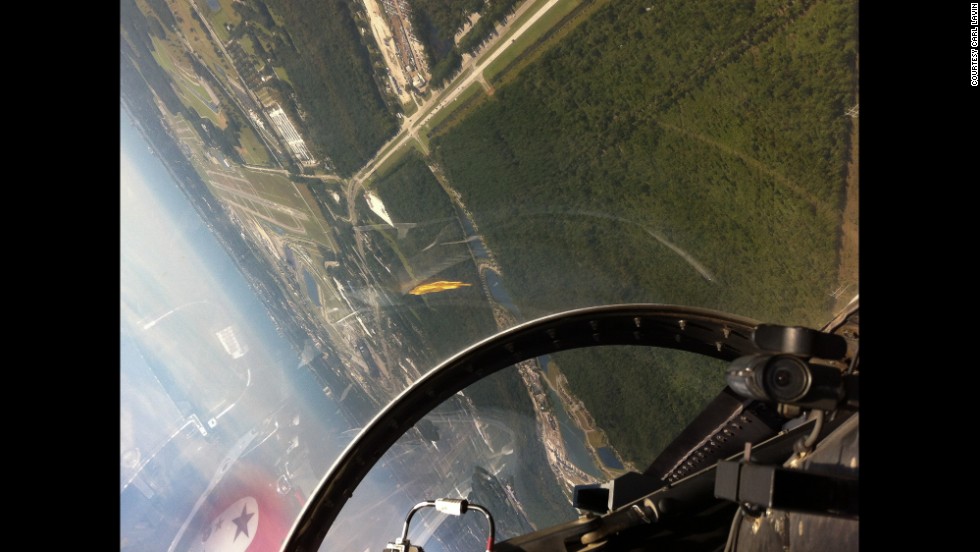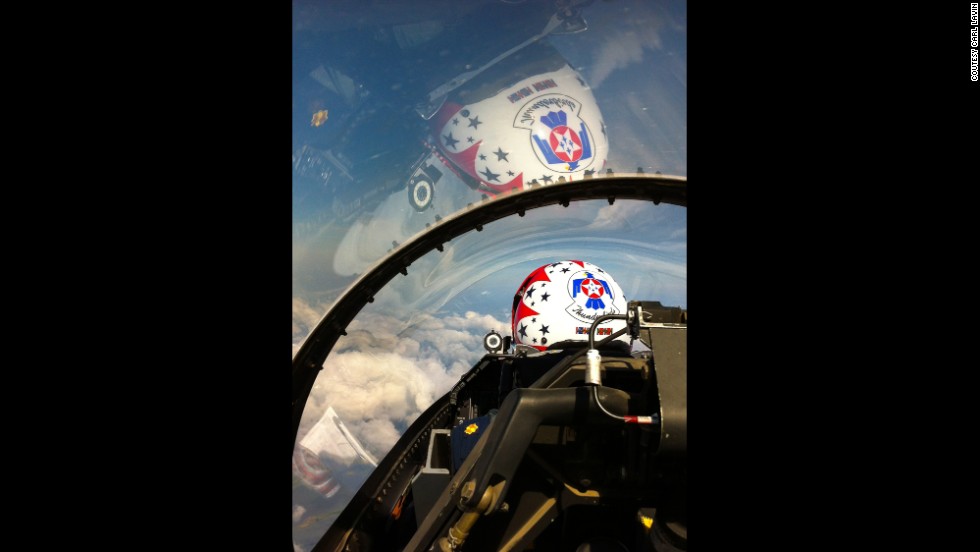Story highlights
- Journalist describes ride aboard F-16 fighter jet including loops, rolls and high-speed turns
- The flight was with the Air Force Thunderbirds, which perform about 30 shows a year
- Some turns made it feel like 8.2 times the force of gravity
Daytona Beach, Florida (CNN)Upside down, a couple of miles above the Kennedy Space Center, the pale green Florida landscape fills the crystal-clear canopy of the F-16.
To the east, a ribbon of sand and a reach of ocean stretch to the horizon.
The Air Force jet rolls 45 degrees, stops and repeats the quick movements three more times. Now we are upright and about midway through my demonstration flight with the Thunderbirds, the precision team that represents the Air Force at 30 air shows a year.
"We are right side up, level flight," Maj. Michael Fisher says from the pilot's seat.
A former F-16 instructor, he has also flown hundreds of combat hours over Iraq. As a member of the elite Thunderbirds, Major Fisher now narrates air shows and takes journalists and select celebrities on demonstration rides.
Loops, rolls, and inverted flight show off the extraordinary capability of the pilot and of the plane, a two-seater version of the fighter jet Air Force aviators fly on the front lines of aerial warfare around the world.
In the back seat, my ability to sit there and do nothing is put to a different test: Turns jostle my stomach, a spinning horizon disrupts my sense of balance, sharp acceleration weighs down my body.
It turns out that the biggest physical challenge I face doing acrobatics in a fighter jet is not when the wings are perpendicular to the horizon or when I am upside down. It's when the plane accelerates into a turn and extra force multiplies the tug of gravity on my body.
I can barely move. It takes the utmost concentration to breathe.
In the same way that a fast lift in an elevator can press you into the floor, a fast acceleration or turn in a fighter jet can press you into your seat. At rest, the force of gravity you feel is measured as 1G. A rising elevator might equal 1.1 G, a sports car in a turn could be 2Gs. After 3Gs, breathing is difficult. After 5Gs, you can lose your peripheral vision. The next step as your brain starts to shut down is called a gray out. Then a black out.
I endured 4Gs early in the flight. Three hours of safety briefings prepared me as well as any civilian. A 24-year-old Air Force staff sergeant, Madeline Conley, fitted me with a jump suit and an extra garment, something like ski pants, but with inflatable bladders over the abdomen and each upper and lower leg. (Sgt. Conley is also in charge of packing the parachute attached to the ejection seat.) That G-suit provides extra protection when it is hooked up to a special air supply in the cockpit. At high G-forces, the bladders inflate, tightening around my muscles, forcing blood to my brain.
During the pre-flight briefing, I sat in an office chair and practiced: clench my feet, tighten my stomach and leg muscles, inhale and exhale with carefully timed, sharp breaths. While the extra force of the high-G turn pulls blood from the brain, this activity is intended to push it back, to equalize the air pressure in my head and to allow me to continue to function.
On the ground it all made sense. Now, however, I am up in the air, a few feet behind Maj. Fisher, with the airspace above the Space Center our aerial playpen. We are wearing oxygen masks and helmets, fitted with microphones and earpieces.
He hears my labored breaths and fitful questions. I hear his even narration as we begin each maneuver: "Here ...comes...the...G." After a few 4-G turns and a 6-G maneuver, Maj. Fisher asks if I am ready for what he says will be a high-G turn. He reminds me: "Breathe every time that I breathe." Then I listen for the "Kff" sound of the major's breaths during his G-force strain, my signal to puff along at his carefully measured pace.
Here we go.
Rolling left. "Kff" My head is buffeting, my arms, which were resting on my thighs, are suddenly too heavy to lift. I tense every muscle. Somehow, an elephant has climbed into the cockpit and is sitting on my lap. But in the time it takes you to read this paragraph, about 12 seconds, we are rolling out of the turn.
"That was an 8.2-G turn. What do you think?" the major's chipper voice asks over the headset. I'm breathing normally again, if normal means how I would breathe after a round with a heavyweight boxer. "That was intense," I reply.
That's 8.2 times your body weight, he says. "That's the force that you're feeling, crushing you down in your chair there."
It's a good time to remember that this is Maj. Fisher's normal workday. "Welcome to my office," he told me right after takeoff from the airport in Daytona Beach, Florida, when we reached our cruise altitude for the short flight to the practice area.
He explains that high-G turns can be useful to get away from a dicey situation, but said it's more likely that he would use the accelerated tight turn in a dogfight, to stay behind an enemy so he can fire a clear shot. "Imagine doing that high-G strain while keeping a visual on your adversary," the major says.
Thunderbirds are Air Force. The Blue Angels? That's Navy.
The Thunderbirds were in Daytona Beach for the every-other-year Wings and Waves Air Show, which attracts about 100,000 visitors. It's sponsored by Embry-Riddle Aeronautical University, which means that for three Thunderbird pilots and a fourth officer, it's also a reunion. Each of the four officers has a degree from Embry-Riddle, which offers highly regarded aviation and engineering programs.
After budget battles grounded the team last year, every member of the Thunderbirds seemed particularly enthusiastic about this show season, which has a grand finale on November 8-9 at the Thunderbird home airfield, Nellis Air Force Base in Nevada. The entire group of 12 officers -- eight of them fighter pilots -- and about 120 enlisted men and women, starts up the season again in March, traveling as a group to support the eight F-16s and to fulfill the squad's mission as ambassadors of the hundreds of thousands of members of the United States Air Force.
The group's spokesman, Maj. Darrick Lee, told me that the group operates on a budget of about $30 million a year. That's roughly the marketing budget for one Hollywood movie. It's an investment that brings the Air Force significant recruiting benefits.
As we head back to the Daytona Beach airport, I manage to pull my phone out of a zippered jumpsuit pocket and shoot a photo. A few puffs of cloud laze over the shoreline. As a journalist, I've flown in a jet trainer, a military cargo plane and on Air Force One. A Thunderbird F-16 flight did not beat them all in comfort, but it came out tops for thrills.


























